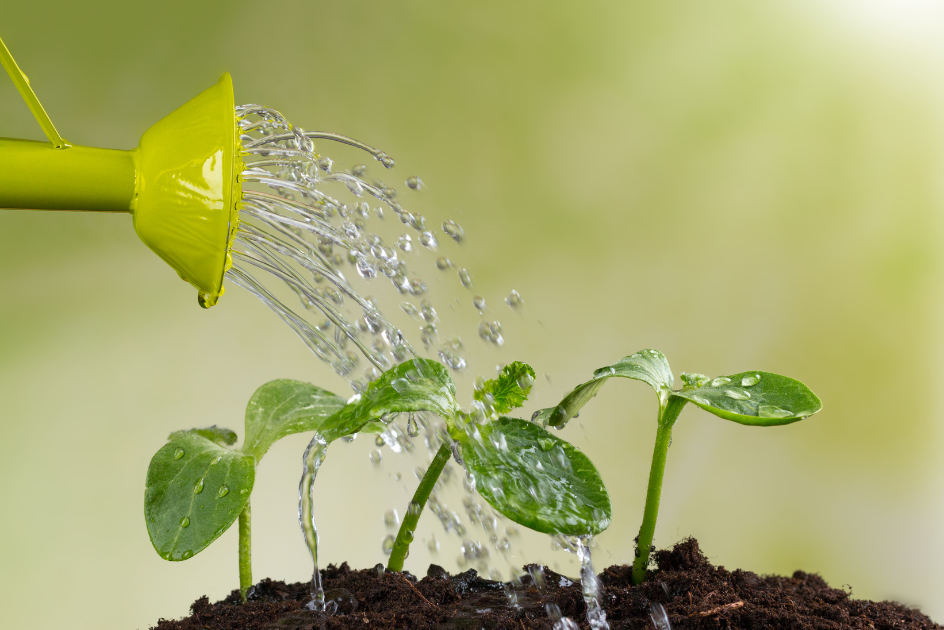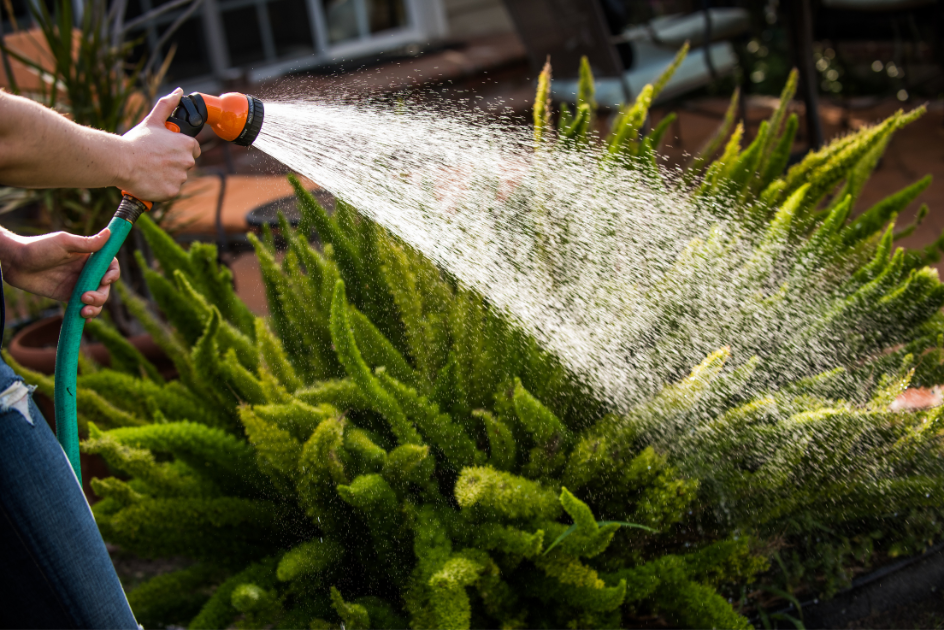Watering Your Plants in the Summer
Watering Your Plants in the Summer
.jpg)
Summer is here, and there is no better time than now to sit in your backyard and enjoy your hard work.
Watering plants in the summer heat can be a challenging task, as the peak-heat temperatures and increased evaporation rate can quickly dry out the soil. It is crucial to provide the right amount of water to plants to ensure their optimal growth, health, and survival during this time.
This guide will provide you with essential tips and techniques to help you navigate the summer heat and keep your plants well-hydrated and thriving. By following these guidelines, you can save water, prevent water-related issues like overwatering or under-watering, and help you maintain your garden throughout the hot weather of the summer season.

Signs Your Plants Need Water
When it comes to taking care of your plants, one of the most important factors to consider is proper watering. Adequate water supply is vital for plants to survive and thrive. If you notice any of the following signs, it means your plants need water.
Drooping Leaves
Firstly, wilting or drooping leaves are a clear indication that your plants are experiencing water stress. When there isn't enough water available, plants lose turgidity and their leaves become limp and lifeless.
Discolored Leaves
Another sign is yellowing or browning of foliage. Lack of water prevents plants from transporting nutrients efficiently, resulting in the discoloration and eventual death of leaves.
Hard, Dry Soil
If you observe soil dryness and cracking, it suggests that your plants are not receiving sufficient moisture. Dry soil reflects the lack of water availability for the roots to absorb and deliver to the rest of the plant.
Stunted Growth
Stunted growth or leaf loss is another symptom of water deprivation. Insufficient water supply hinders the plant's ability to carry out essential metabolic processes, leading to stunted growth or even premature leaf drop.
In the next section, we will look at some of the best practices for watering your plants in summer to ensure they are well watered, without fear of evaporation.
Best Practices for Watering Plants in Summer
Everyone knows how to water a plant. Spray the soil with a hose or douse it using a watering can and you're finished. Right? It's not quite that simple. There are some best practices to follow that will ensure your plants are getting the correct amount of water and you are choosing the right time to water.
Firstly, water deeply and infrequently to encourage deep root growth. This is sometimes called deep watering. This means providing a thorough watering that reaches the root zone of the plants, rather than a light sprinkling. By watering deeply, you encourage the roots to grow deeper into the soil, making them more resilient during hot and dry periods.
Watering early in the morning or late in the afternoon is also crucial. By avoiding midday watering, when the sun is at its highest and temperatures are hottest, you minimize water evaporation and ensure that the water reaches the plants' roots rather than evaporating into the air.
Using mulch around your plants is another effective strategy. Mulch helps retain soil moisture by reducing evaporation and suppressing weed growth. This will not only conserve water but also reduce the competition between weeds and your plants for water resources.
Consider using drip irrigation or soaker hoses to water your plants efficiently and in a targeted manner. These methods deliver water directly to the root zone, minimizing water waste and ensuring that the plants receive adequate moisture.
Lastly, adjusting your watering frequency based on weather conditions and the specific needs of your plants is crucial. During periods of high temperatures or extended dry spells, you may need to water more frequently. Conversely, when rain is abundant, you can reduce watering frequency.
Looking for more ways to help your garden plants thrive? Check out this guide!
By following these best practices for watering plants in summer, you can ensure that your plants thrive and conserve water resources at the same time. Next, let's look at watering techniques for different types of plants.

Watering Techniques for Different Types of Plants
Proper watering is essential for the health and growth of all types of plants, but different plants have different watering needs. In this article, we will discuss watering techniques for container plants, flower beds and garden plants, vegetable gardens, and lawns.
Container plants require proper drainage to prevent waterlogged roots. It is important to choose pots with drainage holes and use well-draining potting soil. Water container plants until water starts to flow out of the drainage holes, ensuring that excess water is removed. Allow the soil to dry out slightly before watering again. The frequency of watering will vary depending on various factors such as plant species, pot size, and environmental conditions.
Flower beds and garden plants should be watered at the root zone rather than the foliage. This ensures that water goes directly to the plant's roots, where it is needed most. Watering the foliage can increase the risk of diseases and wastage. Use a drip irrigation system, soaker hoses, or water directly at the base of the plants. Water deeply and thoroughly, ensuring the soil is moist to a depth of at least 6 inches.
Vegetable gardens require consistent soil moisture to support healthy growth. Mulching around plants can help retain soil moisture and reduce evaporation. Water deeply and thoroughly, ensuring that the soil remains consistently moist. Avoid overwatering, as it can lead to root rot and other issues.
Finally, let's take a look at some water conservation tips.
Water Conservation Tips
Water conservation is a crucial practice that helps to preserve our planet's valuable water resources. This is especially relevant when watering your plants, as droughts can occur during the summer. Reducing water consumption for plants helps mitigate these concerns to make your community more drought-proof.
One effective way to conserve water is by collecting rainwater for watering plants. This can be done by installing rain barrels or other containers to capture the rainwater runoff from rooftops. The collected rainwater can then be used to hydrate plants, reducing the need for freshwater sources. Make sure you look up local and state laws as rainwater collection may be restricted in certain areas.
To further conserve water, it is important to utilize water-saving techniques, such as drip irrigation and mulching. Drip irrigation delivers water directly to the plant's roots, minimizing evaporation and wastage. Mulching, on the other hand, helps to retain moisture in the soil, reducing the frequency of watering.
More tips for a healthy local ecosystem: Learn more about how to plant a garden that is perfect for pollinators!
Another effective technique to optimize watering efficiency is to group plants with similar water needs together. By doing so, water can be targeted to specific areas, reducing excess water usage. It is also crucial to avoid overwatering, as it not only wastes water but also leads to nutrient leaching, which can harm plant health.
Visit Knollwood Garden Center for Your Gardening Needs
Learning the best way to water your plants will help keep your garden healthy even in the summer heat. In addition, proper watering practices can help you conserve water and prevent summer droughts.
If you are looking for new, exciting plants, or want to learn more about specific watering practices for your plants, visit Knollwood Garden Center. Our team of experts can help you find and care for your favorite plants and flowers, and our extensive selection of accessories will help make your garden the perfect place to relax all summer long.
Visit Knollwood Garden Center today!
Satisfied with your Knollwood Garden Center experience? Leave us a review on Google here!
Follow us on Facebook for gardening posts, tips, tricks, and more!
